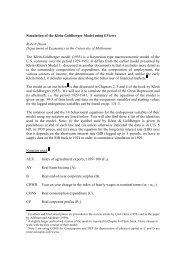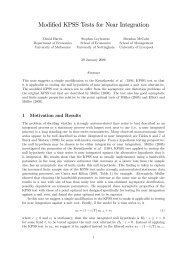1.6 1.4 1.2 1 0.8 0.6 0.4 0 10 20 30 40 50 60 70 80 90 100 0.02 0.018 0.016 0.014 0.012 0.01 0.008 0.006 (a) σ = 0.01 0.004 0 10 20 30 40 50 60 70 80 90 100 8 7 6 5 4 3 2 1 0 0 10 20 30 40 50 60 70 80 90 100 (b) σ = 0.1 FIGURE 11. Price sequence for stable system. FIGURE 12. Top Lyapunov exponent estimation: an unstable system 6. CONCLUSION We have formulated a more general version of the cobweb model, that includes <strong>production</strong> <strong>lags</strong> <strong>and</strong> explicit <strong>forecasting</strong> of <strong>price</strong>s. Power dem<strong>and</strong> <strong>and</strong> supply functions, together <strong>with</strong> a focus on log-<strong>price</strong>s, lead to more or less tractable difference equations for the <strong>price</strong>. The classical cobweb theorem is shown to have extensions in those situations. Complex analysis helps to underst<strong>and</strong> what happens when parameters are changed. We have studied the effect of <strong>price</strong> <strong>forecasting</strong> on stability; when the averaging period m is greater than one, stability requires less stringent conditions on the elasticities than in the classical cobweb theorem. Increasing the <strong>production</strong> lag ℓ may or may not lead to instability, but letting ℓ tend to infinity leads to cycles of constant amplitude. The r<strong>and</strong>om case is expressed as a bilinear model, <strong>and</strong> connects this problem <strong>with</strong> recent work on chaos (Lyapunov exponent of r<strong>and</strong>om matrices). In this respect we have provided some results <strong>and</strong> proofs that may be new. REFERENCES [1] Atkins, K., Marathe, A. <strong>and</strong> Barrett, C. (2007). A computational approach to modeling commodity markets, Computational Economics 30: 125–142. [2] Bélair, J. <strong>and</strong> Mackey, M.C. (1989). Consumer memory <strong>and</strong> <strong>price</strong> fluctuations in commodity markets: An integrodifferential model, Journal of dynamics <strong>and</strong> differential equations 1(3): 299–328. 26
[3] Bougerol, P. <strong>and</strong> Picard, N. (1992). Stationarity of GARCH processes <strong>and</strong> some nonnegative time series, Journal of Econometrics 52(1-2): 115–127. [4] Bougerol, P. <strong>and</strong> Picard, N. (1992). Strict stationarity of generalized autoregressive processes, Annals of Probability 20(4): 1714–1730. [5] Br<strong>and</strong>t, A. (1986). The stochastic equation Yn+1 = AnYn + Bn <strong>with</strong> stationary coefficients”, Adv. Appl. Prob. 18: 211-220. [6] Chiarella, C. (1986). The cobweb model: Its instability <strong>and</strong> the onset of chaos, Economic Modelling 15(4): 377-384. [7] Conlisk, J. (1974). Stability in a r<strong>and</strong>om coefficient model”, International Economic Review 15: 529-533. [8] van Doorn, J. (1975) Disequilibrium Economics, Macmillan studies in Economics, Macmillan Press LTD, London. [9] Dunsby, A., Eckstein, J. <strong>and</strong> Gaspar, J. (2008) Commodity Investing: Maximizing Returns Through Fundamental Analysis, Wiley. [10] Evans, G.W <strong>and</strong> Honkapohja, S. (1988). Economic dynamics <strong>with</strong> learning: new stability results, Review of Economic Studies 65: 23–44. [11] Ezekiel, M. (1938). The cobweb theorem, Quarterly Journal of Economics 52: 255–280. [12] Goldberg, S. (1986) Introduction to Difference Equations, Dover Publications Inc, New York. [13] Goodwin, R. (1947). Dynamical coupling <strong>with</strong> special reference to markets having <strong>production</strong> <strong>lags</strong>, Econometrica 15(3): 181–204. [14] Horn, R.A., <strong>and</strong> Johnson, C.R. (1985). Matrix Analysis. Cambridge University Press. [15] H. Furstenberg <strong>and</strong> H. Kesten (1960). Products of R<strong>and</strong>om Matrices, Ann. Math. Statist. 31(2): 457-469. [16] Kesten, H. <strong>and</strong> Spitzer, F. (1984), Convergence in distribution of products of r<strong>and</strong>om matrices, Wahrscheinlichkeitstheorie und Verw.(67): 363-386. [17] J. F. C. Kingman (1973). Subadditive Ergodic Theory, Ann. Probability, 1: 883-909. [18] Meadows, D.L. (1970) Dynamics of Commodity Production Cycles, Wright-Allen Press. [19] Metzler, L. (1941). The nature <strong>and</strong> stability of inventory cycles. Review of Economics <strong>and</strong> Statistics 23(3): 113-129. [20] Muth, J.F. (1961). Rational expectations <strong>and</strong> the theory of <strong>price</strong> movements, 29, 3: 315-335. [21] Ng, S. <strong>and</strong> Ruge-Murcia, F. (2000). Explaining the persistence of commodity <strong>price</strong>s, Computational Economics, 16: 149 - 171. [22] Nicholls, D.F. <strong>and</strong> Quinn, B.B. (1982) R<strong>and</strong>om Coefficient Autoregressive models: An Introduction, Lecture Notes in Statistics, Springer, New York. [23] Philips, A.W. (1957) Stabilization policy <strong>and</strong> the time-forms of lagged responses. Economic Journal 67(June): 265-277. [24] Pryor, F.L., <strong>and</strong> Solomon, F. (1982) Commodity cycles as r<strong>and</strong>om processes. European Review of Agricultural Economics 9: 327-346. [25] Remmert, R. (1991) Theory of Complex Functions, Springer, New York. [26] Samuelson, P. (1973) Mathematics of speculative <strong>price</strong>. SIAM Review 15(1): 2-42. [27] Sterman, J.D. (2000). Business Dynamics: Systems Thinking <strong>and</strong> Model for a Complex World. McGraw Hill, Boston, Massachussets. [28] Smyth, D.J. (1973). Effect of public <strong>price</strong> forecasts on market <strong>price</strong> variation: a stochastic cobweb model, American Journal of Agriculture, 55, 1: 83-88. [29] Turnovsky, S.J. (1968). “Stochastic stability of short-run market equilibrium under variations in supply”, Quarterly Journal of Economics, 82: 666-681. [30] Vanneste, J. (2010). Estimating generalized Lyapunov exponents for products of r<strong>and</strong>om matrices, Phys. Rev. E, 81(3): 036701. [31] Vervaat, W. (1979). On a stochastic difference equation <strong>and</strong> a representation of non-negative infinitely divisible r<strong>and</strong>om variables, Adv. Appl. Probab. 11: 750–783. [32] Wheaton, W. (1999). Real estate “cycles”: some fundamentals, Real Estate Economics 27(2): 209-230. DANIEL DUFRESNE, CENTRE FOR ACTUARIAL STUDIES, UNIVERSITY OF MELBOURNE DUFRESNE@UNIMELB.EDU.AU FELISA VÁZQUEZ-ABAD, DEPARTMENT OF COMPUTER SCIENCE, HUNTER COLLEGE, CUNY FELISAV@HUNTER.CUNY.EDU 27







